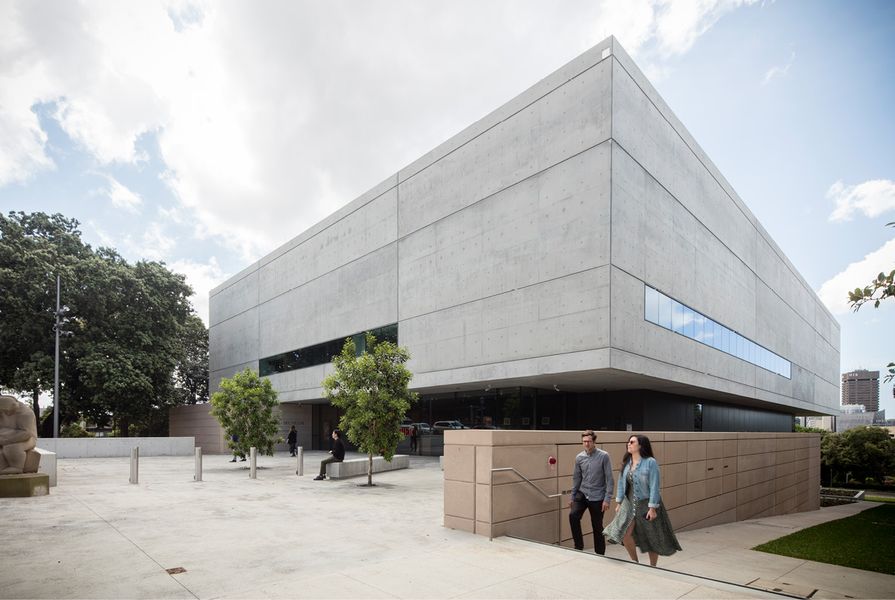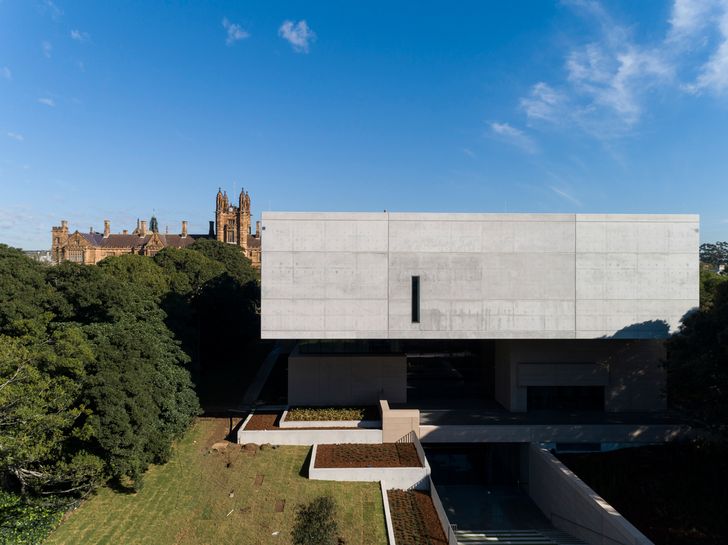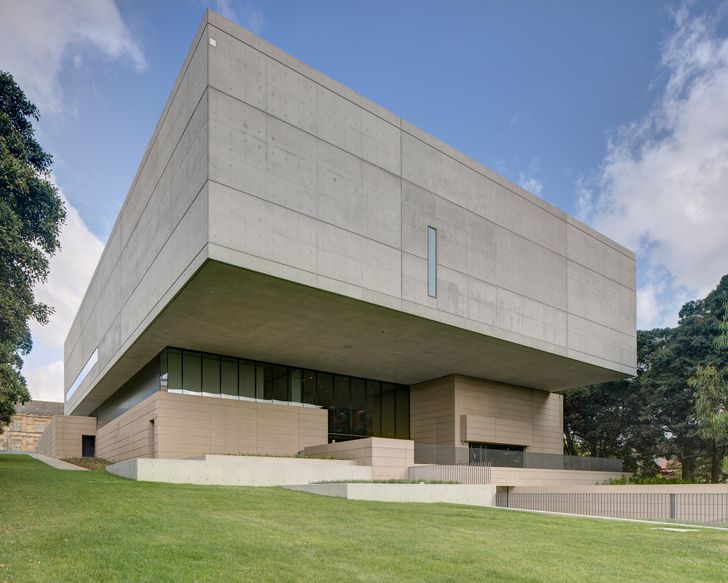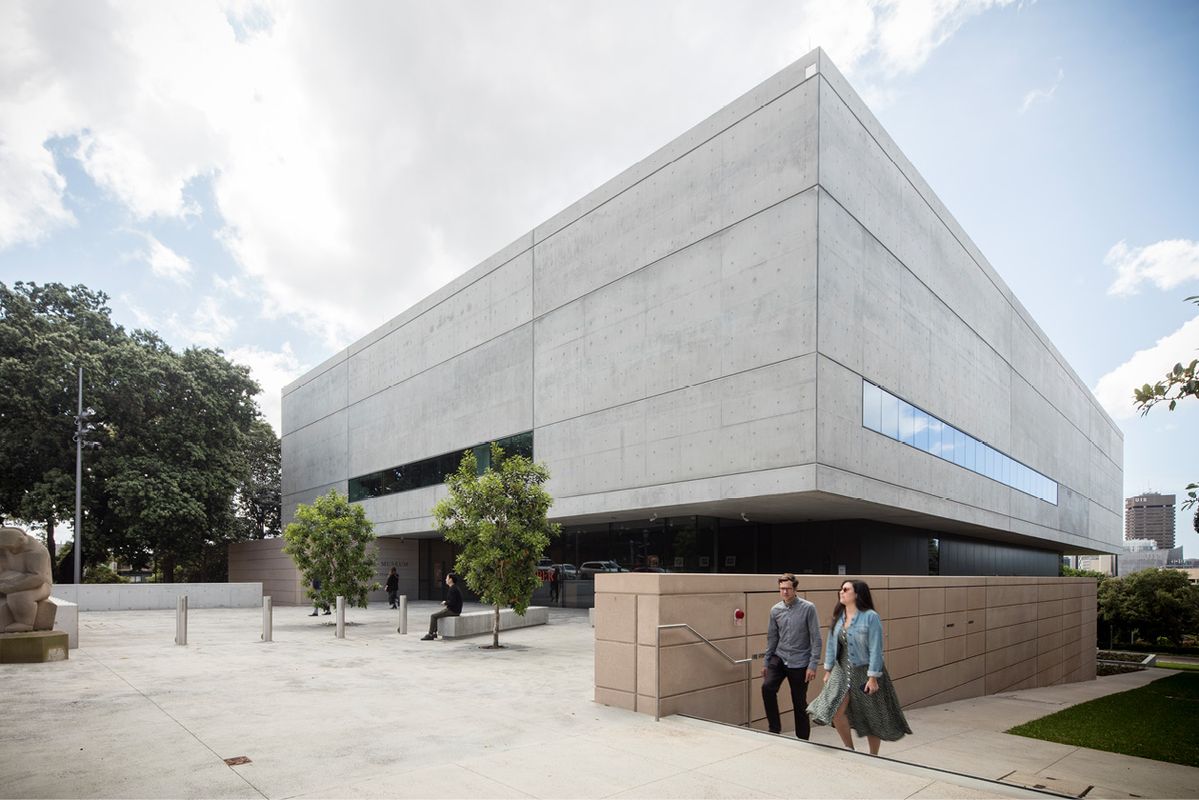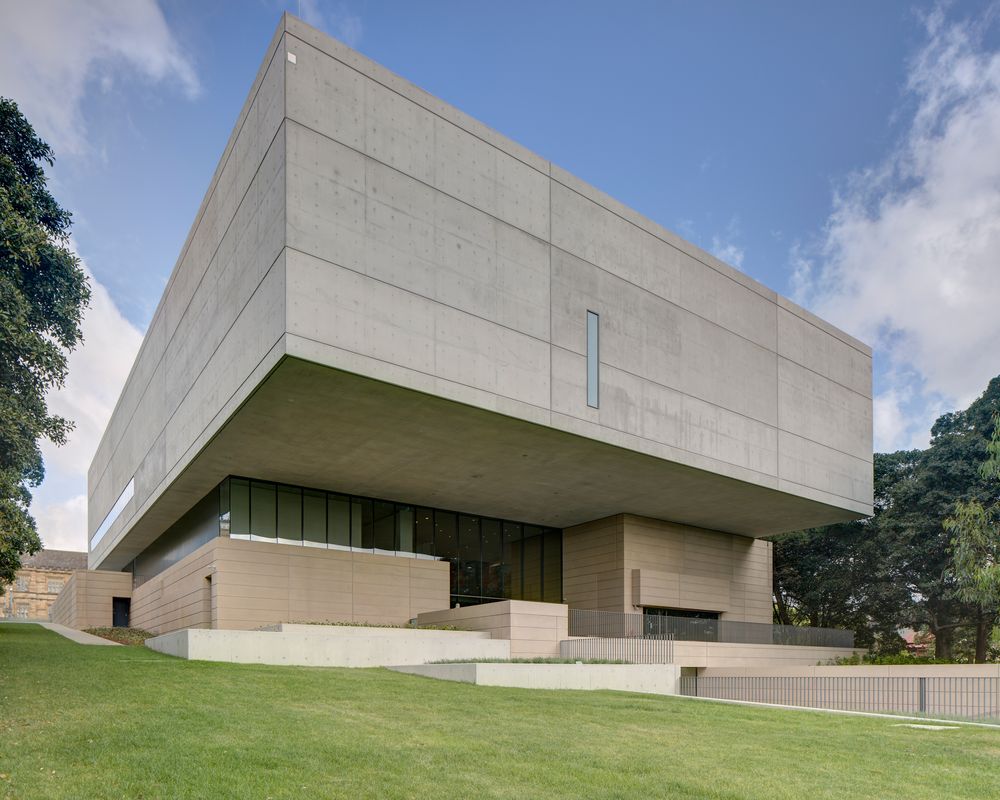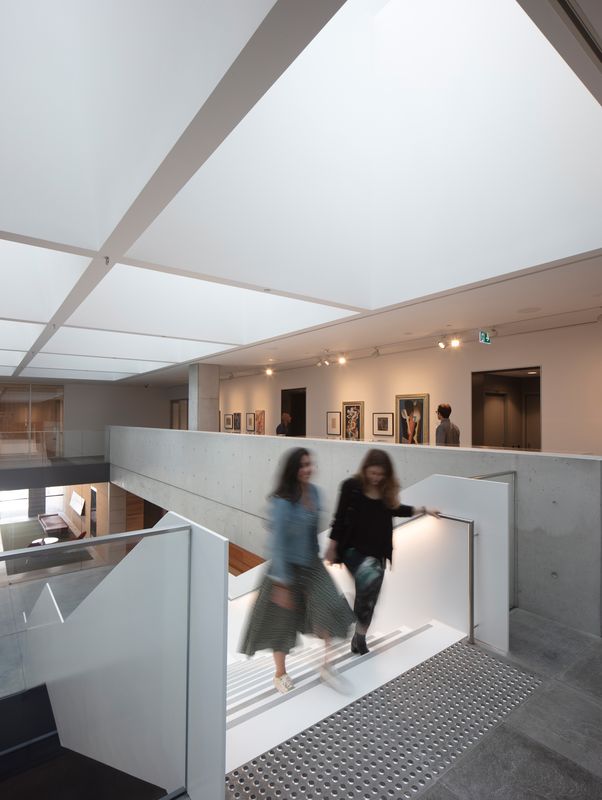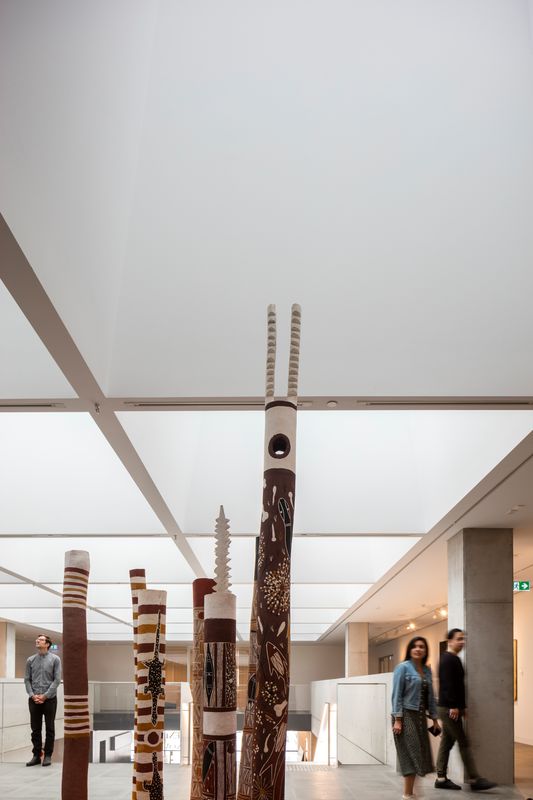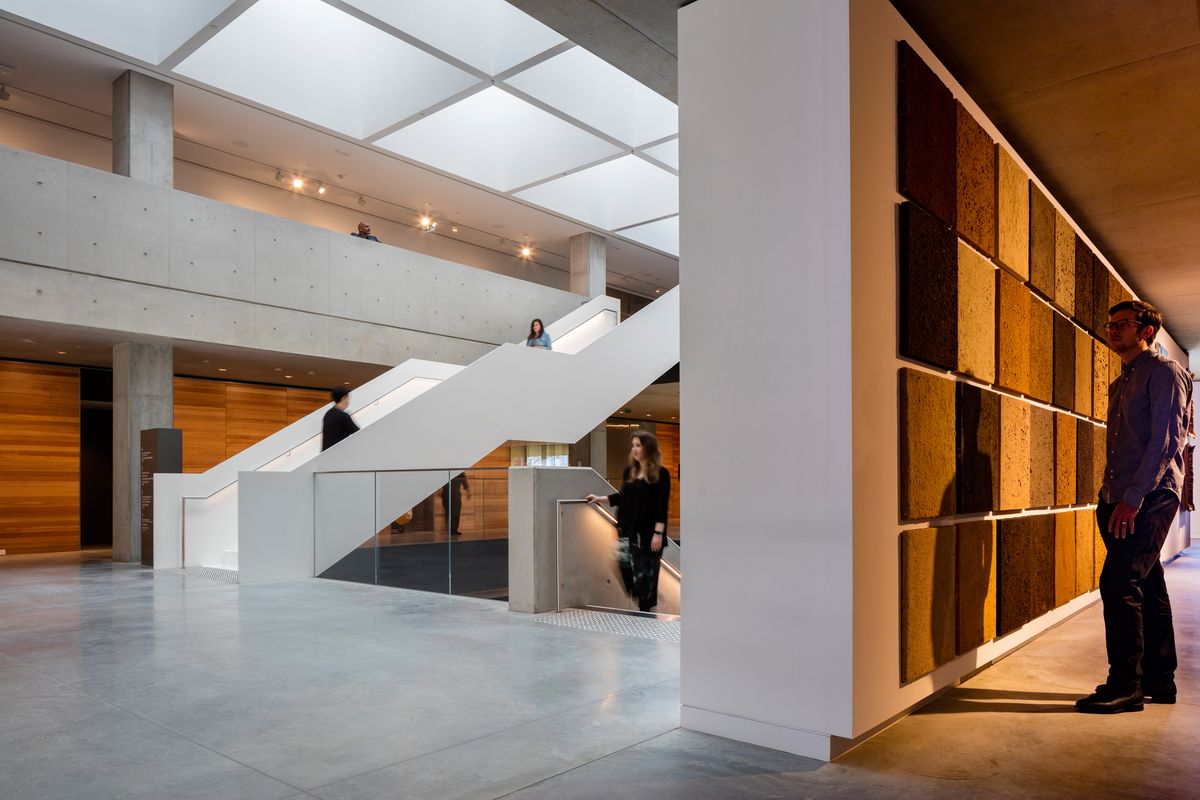We like this building; it seems poised within its physical context. By poised, we mean composed and separate from its context, but at the same time somehow enigmatically reactive to the particular nature of that context.
The building is Johnson Pilton Walker’s (JPW) Chau Chak Wing Museum at the University of Sydney, which brings together the existing Nicholson, Macleay and University art collections to enable a profound increase in accessibility for students, academics and the general public. Alongside exhibition spaces, the new building will also provide a substantial collections store, loading and conservation facilities, a diverse range of internal and external learning environments, and numerous event spaces.
Form
As we stand on the loop of University Place before the entrance, with the radical flatness of the long singular strip window and the unadorned concrete facade reflecting the afternoon light, the building appears unapologetically modern. In this sense, the allusions unfurl easily: Villa Savoye, Paulo Mendes da Rocha, the Met Breuer and Col Madigan’s tough lyricism. But in our experience within and around the building, that formal clarity is combined with axial symmetry, front-to-back processional transparency and a relation to the bucolic setting that conjures something distinctly more classical, even Palladian.
In the writers’ favourite photograph, the museum’s unadorned facade appears “unapologetically modern.”
Image: Brett Boardman
Still, the architecture is more blunt than that of European neoclassicism. A wonderfully arresting photograph of the building in context by Brett Boardman (below) frames the architecture in a way that is neither modern nor classical. It is an elevated vista of the precisely illuminated form framed by the verdant foreground foliage, with Edmund Thomas Blacket’s Quadrangle (1859) partially obscured beyond. The building reads as a monolith.
If abstraction is the act of removal to achieve the essential, the result is the meeting of characteristics of the sublime and the banal. Solid, mute and without human scale, the architecture seemingly shrugs more normative canonical associations and becomes simply archaic. Though perhaps with less affinity to Uluru or the Great Pyramids, the autonomous form conjures something of Kubrick’s 2001: A Space Odyssey – an enigmatic object of ambiguous meaning.
Architectural form establishes a relationship to context that is imbued with both tangible meaning and connotation. In this sense, the hovering box, while clearly legible as something substantial and protective, remains a stark example of the domination of the ground. The reading of form within a typological context is also revealing. The great paradox of the museum as a type is that the objects collected are always shadowed by the alternate history that might be established by those excluded. Given that the box is the prototypical architectural form of defined limit, this act of inclusion/exclusion is brought into even sharper relief.
The museum will be open seven days a week, indicating its intent to welcome public interaction.
Image: Brett Boardman
The significance of the formal architectural response is amplified by the decision to adopt the current site on the old tennis courts. The making of a clearly defined space where once there was a looser pattern of habitation results in the severing of the open space continuum of the city. Vistas are extinguished, graceful fabric demolished, land re-formed, shadows cast and flora interrupted. In such cases, the onus on the act of establishing an appropriate architecture intensifies. But it is not simply the architecture; the operation of the institution and the ongoing accessibility of the building, the collection and the curatorial strategy will be the ultimate arbiter of the success of the project.
Ground
This initial, form-based reading of the architecture needs to be balanced with the experiential. And here it becomes apparent that the internal logic is not simply a manifestation of the singular form, but largely comprises spaces resulting from an infrastructure of topographical manipulations. While the monolith contains the temporary exhibition space (a wonderful new addition to the suite of Sydney’s great public rooms), as well as conservation, administration and service spaces, it is within the ground, or enclosing walls, that the majority of the publicly accessible spaces are located.
Within these spaces, the blurred threshold at the edge of conditioned space, and mechanisms such as glazing, fences and landscape walls, are skilfully designed to enable security, while strategically expanding and contracting the usable volumes available to the institution. Hopefully, the museum finds the confidence to loosely inhabit these liminal spaces, with informal appropriation by the public encouraged. It is a significant indication of this intent that the museum will be open seven days a week, so that there is a reaching out in time as there might be in space to welcome public interaction.
Natural light pours in through a grid of subtle wedge section baffles. Artwork: Yolngu hollow log memorials, Milingimbi Makarrata, 2016.
Image: Brett Boardman
This working with the notion of shared ground seems particularly timely as our institutions seek a more authentic relation to both our ancient cultural tradition and the polyvalent contemporary condition. It is somehow emblematic that at the outset of construction, the benefactor, Dr Chau, broke the ancient wallaby ground with a personal acknowledgement of Country spoken in Mandarin.
Procession
The internal spatial strategy is one of immense clarity. Past the wonderful compression of the entry threshold, the light intensifies and the interior expands dramatically upwards to a remarkable zenithal light comprising a grid of subtle wedge section baffles.
Within, procession is enabled via a relatively simple circuitous route of stacked compact floor plates accessible from the central atrium. But the slope of the land and the spatial impact of the various integrated service spaces within the form, which adopts a strict adherence to an upper relative level of 48.35, create an opportunity to establish spaces with a pleasing variation in height. This experience is a manifestation of Robin Evans’ “matrix of connecting rooms” 1 and verges on the dynamic interior experience of a Raumplan. The section emphasizes planning nuances and generates delightfully dynamic interior spaces.
Spatial diversity is driven by and further accentuates the curatorial diversity of the institution. It will be exhilarating, in such a compact building, to find the juxtaposition of a pharaoh, a Lego city, rock carvings, a contemporary art commission, Cypriot pottery and a cafe. The curatorial strategy to engage four different practices for the design of the inaugural exhibitions, the reuse of the Macleay display cases and the strategic integration of vitrines into the architecture support this Wunderkammer strategy. The spatial and material diversity of the interior has the real potential to operate like an instrument for the pluralistic weaving together of divergent cultural histories.
The building’s enclosing walls act as beams that enable the cantilever.
Image: Brett Boardman
Material
The material character is robust. The finite form is rendered in raw, almost industrial, off-form concrete walls, 450 millimetres thick. The concrete will weather, the marks of its making recede and the patina increase. We are reminded of Richard Leplastrier’s observation that a building is not at its most beautiful at the moment in which it is first inhabited. It is likely this building will wear its patina with a similar grace to that of the adjacent Fisher Library (designed by the NSW Government Architects Branch and completed in two stages, in 1962 and 1971). The great monolith will blacken as the surface weathers and the soft fissures within the material open to accept the effects of the sun, wind and rain. It is refreshing for a major cultural building to be built in a manner that allows the effects of the weather to increase its aesthetic, scenic qualities over time.
The design employs finish as structure and the form necessitates a specific structural design wherein the enclosing walls act as beams that enable the cantilever. All is cleverly optimized to smoothly navigate the Design and Construct procurement process, in which things that are not essential tend to become value-managed.
There are clear indications in this project of the influence of JPW’s work with Jørn Utzon on the Opera House. At one scale, it is evident in the adoption of an emblematic form held aloft over remade ground via evocative sand-coloured precast panels; at another, there is the judicious use of muscular concrete detailing and subtler touches, such as the comforting wash of illumination held within a curved metal handrail.
But perhaps more prescient is the understanding that the stones of our institutions make manifest the evolving values of our society in a way that is as self-evident as it is irrefutable. The capacity for the architecture of public buildings to have a distinctive and formal clarity, to make an autonomous contribution to the urban fabric, is as vital as the responsibility to make places that are inviting and open-ended, places that give dignity to experience.
Robin Evans, “Figures, doors and passages,” in Translations from drawing to building and other essays (London: Architectural Association Publications, 1997).
Credits
- Project
- Chau Chak Wing Museum
- Architect
- Johnson Pilton Walker
Sydney, NSW, Australia
- Project Team
- Kiong Lee, Graeme Dix, Supinder Matharu, Daniel Wainwright, Marguerite Farmakis, Timothy Clare, Isabel Gallego Estaben, Matteo Salval, Thomas Studholme, Matthew Asimakis, Samuel Carslake, Lukas Bimmerle, Julia Young, Alex Prichard, Jerry Feng,, Jacques Chevrant-Breton, Emma van Lint, Oliver Ju, Evelyn Li, Gavin Xu, Bella Zhang
- Consultants
-
Civil and structural engineer
Arup (tender), Northrop (construction)
Mechanical, electrical and hydraulic services Arup (tender), Integrated Group Services (construction)
Specialist lighting and ESD Steensen Varming
- Aboriginal Nation
- Built on the land of the Gadigal people of the Eora nation.
- Site Details
-
Location
Sydney,
NSW,
Australia
Site type Urban
- Project Details
-
Status
Built
Completion date 2020
Category Public / cultural
Type Museums
Source

Project
Published online: 12 Apr 2021
Words:
Anita Panov,
Andrew Scott
Images:
Brett Boardman
Issue
Architecture Australia, January 2021

